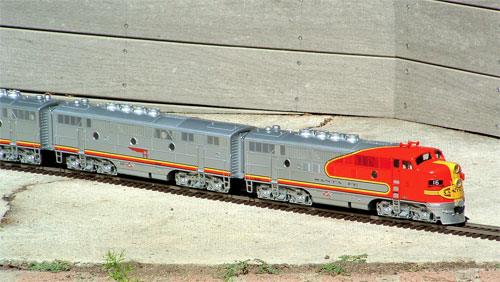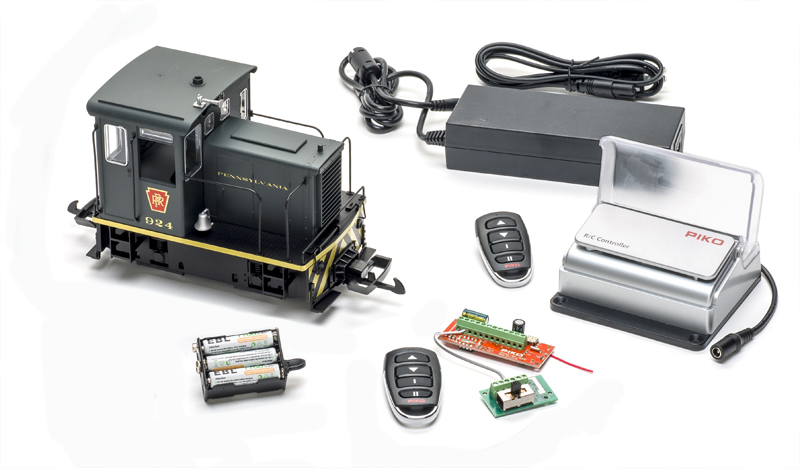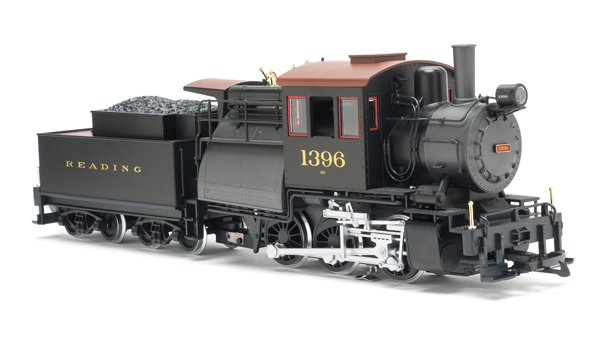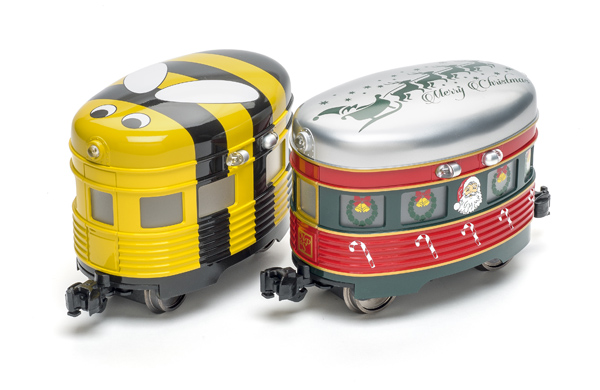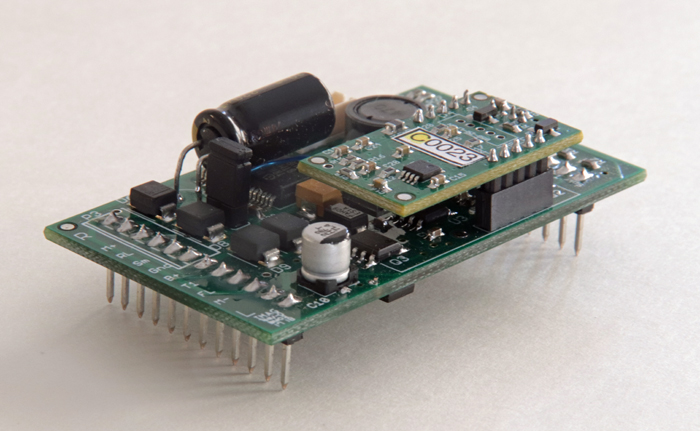1:32 scale, gauge 1, ready-to-run F3 A and B diesel engines
MTH Trains
7020 Colombia Gateway Drive
Columbia MD 21046
Price: F3 A (pair) $699 95;
F3 B (each) $249.95
Web site: www.mthtrains.com
Plastic models of EMD F3 A and B (lead, booster, and cab) diesel locomotives; models have modular electrical connections; two, two-axle power trucks; one motor per truck; directional front and rear headlight; electronically simulated Mars light; lighted number boards; interior cab lighting and details; operating smoke unit; sound system; metal grab rungs and lift rings; operating knuckle couplers; opening doors; accurate prototypical graphics and road numbers. F3 B (booster) units are non-powered (no motors, smoke, sound, or lighting). They do have modular connections with jumper cables to electrically tie the two A units together. Dimensions: A units: overall length (with JME or Kadee couplers), 19″; width, 4″; height, 6″. B units: overall length (with JME or Kadee couplers), 18.75″; width, 4″; height, 6″. In 1:32 scale, this works out to a correct 50′ 8″ x 10’8″ x 16’0″ for the A unit, and 50’0″ x 10’8″ x 16’0″ for the B unit
Pros: Correct scale (1:32) for #1-gauge track; the most accurate, injection-molded F3 diesel-electric models ever produced for #1 gauge; very good detail; rugged; good puller; more reliable on semi-scale track than 1:29 diesel models; JME- and Kadee-coupler compatible; directional lighting; very good sound; excellent smoke unit
Cons: Semi-scale wheelsets not available; F3 A curved nose shape slightly incorrect; stainless-steel side panels not represented (Santa Fe
units only)
These are the most accurate injection-molded-plastic F units ever produced for gauge-1 track. They represent a significant improvement over other plastic diesel models in 1:32 or 1:29 scales. These models represent not as-delivered, but midphase modified units.
This engine is an excellent puller, due to the two motors powering the two, four-wheel trucks, the adequate weight, and the two axles that have rubber tires on their wheels. At the time of this test, the F3 A units had about two hours running time. The following results are for the lead A unit. Sound came on at 7V and 0.2 amps. Lights came on at 8V and 0.3 amps. Minimum scale speed without stall or hesitation was about three mph at about 10V and 0.5 amps. With 20 cars, the minimum forward speed dropped to about two scale mph. Scale speed at 19V was 82 mph. To take advantage of all the features for R/C operation, you’d need three six-cell packs instead of two (as is more typical for 1:32 engines). On level track the drawbar capacity was 72 ounces, or about 58 average freight cars at approximately 3 amps. For a single engine this is impressive. The lead A unit can be run alone. Use of both A units would improve performance by lowering the slow-speed threshold and, of course, increasing the maximum number of cars capable of being pulled.
The model has directional lighting, including headlight, cab light, and electronically simulated Mars light. The single-bulb Mars light is correctly placed in the upper housing. MTH’s C unit Mars light worked best, as it dimmed instead of fully going out like the lead unit’s. The cab light is too bright. I’d recommend replacing it with a higher voltage bulb or eliminating it altogether.
MTH has chosen to sell the two A units as a pair. The lead unit has track pickup, two motors, full lighting, smoke, sound, and smoke-and-sound controls. The C unit has track pickup, two motors, full lighting, and smoke. It does not have a sound system (or speaker), nor does it have direct connection of the track pickup to the motors. It does not have a control pot for the smoke, either. MTH calls it a “slave” unit, as, out of the box, it must be connected to the lead unit via supplied cables (cleverly hidden in the diaphragms). There are advantages and disadvantages to this. If you want to buy a single A unit, you’re out of luck. If you’re going to R/C the engine (something I recommend in general), this is not a problem; in fact, there’s less work involved with the slave A.
The F3s come with both MTH knuckle couplers and LGB-type hook-and-loop couplers. They also have mounting holes for JME or Kadee (#920 or #820) 1:32-scale couplers, which mount to the body. The model will negotiate four-foot-radius curves with the Kadee’s.
The model is impressively designed as regards to internal access. There is extensive use of mini plugs inside the body that allow easy disconnection of the motor blocks, smoke unit, sound system, and cab lights for servicing.
The smoke unit has a fan with adjustable speed output. This is the best diesel smoke unit I’ve seen. The smoke is very realistic, billowing along the top of the units. It reminds me of the nasty exhaust that used to cause smog alerts in LA when I was a kid.
The sound system is designed to provide full functions on AC voltage, (the horn is only accessible with MTH’s DCS system or another AC trigger, such as Lionel’s GP-7’s horn button). However, it does provide idle when the engine is sitting still, but with power applied, and a rev-up once the engine is moving. In addition, during idle, cab chatter can be heard intermittently. The sound level of the voices was too loud in relation to the prime mover, and distorted. The diesel-engine recording is good; the only real criticism is a lack of low-frequency response. However what is there is convincing, especially from about 20 feet away. There are two easily accessible trim pots for sound volume and smoke level, nicely hidden behind the lead cab’s left-side rear door.
The overall appearance on the model is impressive. MTH has done their homework with respect to the model’s paint and graphics overall. However, there is one thing about the Santa Fe units that isn’t right. This has never been done correctly in 1:32 or 1:29 by any manufacturer. The A and B units had some stainless-steel side panels and some painted silver panels, along with the roof and trucks. The MTH units represent the panels as all painted.
The grills and underlying frame pieces are really fantastic, as are the grills for the roof dynamic brakes. The numbers that MTH chose are also correct for these SF engines.
There are a couple of noticeable problems that should be fixed. The wipers are oversized and the wall thickness around the windows is a bit too thick. The nose shape and window-framing angle is not quite right; it’s close, but this is one aspect of F units that many manufacturers have a great deal of difficulty getting exactly right. Full-size engines’ noses were basically hand made out of steel plate that was welded and ground into shape. This was a laborious process that resulted in some slight variation from unit to unit. Even so, this F3’s nose has a bit of a pointy, high cheek bone (the best way I can describe it).
Out of the box, the lead unit has a scale pilot and dummy coupler that will mate with Kadee #921, #821, #920, or #820 couplers. The trailing (C unit) has a larger cutout pilot with MTH’s “G” scale coupler, as do the B units. The pilot and couplers can be replaced for finescale operation (parts are available from MTH).
The F3 is provided with coarse-scale (high rail) wheels for code-332 rail. However it will also run on all code-197, -215, and -250 track (except for Märklin’s code 205). Although the MTH wheels have the same flange depth as 1:29-scale diesels, I’d like to see the company offer replacement wheelsets with semi-scale flanges. These would match 1:32-scale brass engines and would look better on finer-scale track. Even with the deep-flange wheelsets, the MTH F3 ran more reliably through trackwork than 1:29-scale engines. This is because MTH uses a narrower flange and spaces their wheelsets to the new NMRA back-to-back wheelset standard of 1.575″ (40mm). This is the same dimension used by Gauge 1 Model Railway Association and the NMRA for semi-scale wheels and track.
Although not typical of models in this price range, it would be nice if the trucks had working suspension bolsters. The journal boxes are separate castings with working springs and could be made to work with minor modifications on MTH’s part.
MTH diesels keep getting better. This is an excellent product and, with a few modifications, would qualify as a fine-scale model. As good as the A and B units look and run alone, I’d recommend getting the full A-B-B-A lashup. This is the way EMD envisioned their engines to be used and it is one of the most impressive model-railroad sights I’ve experienced.





